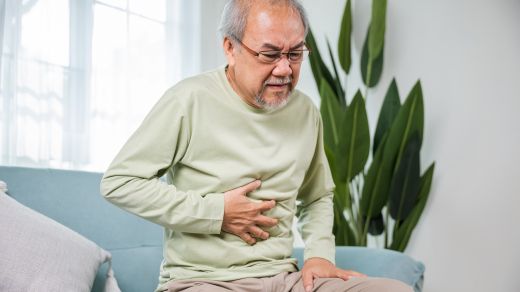The inside of the stomach is lined by mucous membrane – these cells can develop into stomach cancer. The common cause is a stomach ulcer, often caused by Helicobacter pylori. What symptoms can indicate carcinoma and how it is treated.
- © sorapop – stock.adobe.com
Quick overview: stomach cancer
Definition: Stomach cancer is a malignant tumor of the stomach lining. Medically it is also known as stomach cancer.
Symptoms: Initially often non-specific, such as stomach pain, nausea, persistent loss of appetite. Later, unwanted weight loss, difficulty swallowing and tarry stools (dark-colored stools caused by bleeding in the stomach) are possible.
Causes: Risk factors include chronic stomach inflammation and stomach ulcers caused by Helicobacter pylori infections, a genetic predisposition, smoking or high alcohol consumption.
Diagnosis: Physical examination, gastroscopy (gastroscopy), blood values and, if necessary, imaging examinations of the abdominal cavity.
Treatment: Treatment options include surgical removal of the tumor, chemotherapy, radiation therapy and targeted therapies. In advanced stages, stomach cancer is difficult to treat.
Article contents at a glance:
What is stomach cancer?
If a malignant tumor forms in the stomach, experts speak of stomach cancer (stomach carcinoma). The most common type of stomach cancer is adenocarcinoma, which arises from the glandular tissue of the mucous membrane. MALT lymphomas originating in lymphatic tissue and soft tissue tumors, such as gastrointestinal stromal tumors (GIST), are much rarer.
Early gastric cancer refers to adenocarcinomas of the stomach that are limited to the mucosa and the underlying layer, the submucosa. It doesn’t matter whether lymph nodes are affected or not.
Every year, around 17,000 women and men in Germany develop new stomach cancer. The average age at onset in women is 75 years. On average, men are diagnosed with stomach cancer at the age of 71.
Symptoms that may indicate stomach cancer
Stomach cancer often causes only a few and rather uncharacteristic symptoms, especially at the beginning. In early gastric cancer, digestive disorders (dyspepsia) can occur as a symptom. Which includes
burning, cramp-like or dull pain in the upper abdomen,
frequent belching,
Heartburn and bloating as well
a “sensitive stomach” with a pronounced aversion to certain foods.
A new intolerance, for example to coffee, fruit or alcohol, can also be a sign of stomach cancer. Because these symptoms are nonspecific, they are often mistaken for food intolerance.
In advanced stages, stomach cancer can cause symptoms such as
Vomiting blood and tarry stools (black, sometimes foul-smelling stools) can also occur.
Diagnosis of stomach tumors
To make the diagnosis, the doctor asks about your medical history and any symptoms you are currently experiencing. If stomach cancer is suspected, a gastroscopy is carried out. A flexible tube (endoscope) about 1.2 meters long and one centimeter thick is pushed through the mouth and esophagus into the stomach and the beginning of the small intestine (duodenum). There is a camera at the tip of the tube that can be used to visualize the mucous membrane inside the organs.
If there are any abnormal findings, tissue samples (biopsy) can be taken from the mucous membrane using small forceps. The examination does not cause any pain. However, inserting the endoscope can cause an unpleasant choking sensation. If necessary, a sedative can be administered beforehand.
Further tests to diagnose stomach cancer
If a malignant tumor in the stomach lining has been diagnosed, doctors use imaging techniques to determine the stage of the disease:
At the Computed Tomography (CT) the extent of the tumor can be determined using a contrast agent. This shows whether it has already grown into the stomach muscles via the mucous membrane and the underlying tissue or has affected lymph nodes, larger blood vessels and surrounding organs.
For the endoscopic ultrasound Sonography is combined with a gastroscopy. In particular, the local extent of the tumor within the various layers of the stomach wall can be easily checked.
roentgen and possibly a mirror examination of the lungs (bronchoscopy) are used to detect secondary tumors (metastases).
One laparoscopy This is usually done when there is a suspicion that the peritoneum may be affected.
In addition, one will Blood test caused. Tumor markers such as CEA (carcinoembryonic antigen) as well as CA 72-4 and CA 19-9 (cancer antigen) are measured in the blood.
Stages of the disease in stomach cancer
The staging is done using the so-called TNM classification according to the size and degree of spread of the tumor: T = tumor, N = involvement of regional lymph nodes, M = metastases in other organs.
Table: Classification of stages according to TNM classification
| classification | characteristics |
| T1 | Infection of the stomach lining (mucosa) and the underlying submucosa |
| T2 | Infection of the muscle layer underneath the mucous membrane |
| T3 | Infection of the tunica serosa, the outermost layer of tissue |
| T4 | Infestation of surrounding structures |
| N1 | 1-2 lymph nodes affected |
| N2 | 3-6 lymph nodes affected |
| N3a | 7-15 lymph nodes affected |
| N3b | >15 lymph nodes affected |
| M0 | No distant metastases |
| M1 | Infection of other organs |
Which promotes the development of stomach cancer
According to current research, a number of causes and risk factors for stomach cancer are known.
The most important cause is chronic inflammation of the stomach lining (gastritis), which often initially leads to a stomach ulcer. If the inflammation continues, it can cause the mucous membrane cells to change and ultimately degenerate into cancer cells. The pathogen Helicobacter pylori plays a crucial role. People who have an infection have a two to three times increased risk of developing stomach cancer.
Other triggers:
Reflux: The backflow of stomach contents into the esophagus (reflux) can promote the development of cancer in the transition area between the esophagus and stomach.
Nutrition: A diet low in fruit and vegetables increases the risk of disease. The reason is probably the antioxidant effect of the vitamins and plant substances contained in fruits and vegetables, such as vitamin C, E and beta-carotene. Salt-rich foods and meat, especially cured meat products, are also considered risk factors for stomach cancer. When curing meat products, nitrate and nitrite salts are used, which form carcinogenic nitrosamines both when heated and in the stomach.
Alcohol and nicotine: Smoking and excessive alcohol consumption also increase the risk of stomach cancer.
genetic predisposition: Studies show that stomach cancer occurs more frequently in some families. If there are certain hereditary changes in the so-called E-cadherin gene, first-degree relatives of patients have an increased likelihood of developing stomach cancer themselves. The disease also appears much earlier in them.
Stomach cancer treatment options
In advanced stages, treatment of stomach cancer is difficult and the chances of survival are comparatively lower than with other types of cancer. Around 33 percent of patients live longer than five years after diagnosis.
Surgical, partial removal of the stomach is often the primary treatment method. To remove any cancerous tissue, a complete gastrectomy is often necessary. Afterwards, a relatively normal diet is usually possible – those affected should eat five to eight small meals per day instead of large portions.
In rare cases, older patients can undergo stomach-preserving surgery, although this affects the prognosis.
For people with a promising prognosis, removal of the lymph nodes is often recommended. The decision to do this depends on factors such as tumor stage, age and physical condition.
Chemotherapy and radiation
5-Fluorouracil-based chemotherapy after surgery can prolong the time without symptoms and improve overall survival.
For locally advanced tumors, a combination of chemotherapy and radiation therapy can shrink the tumor. A smaller tumor can then often be completely removed surgically.
Targeted antibody therapy
A novel treatment for advanced, metastatic stomach cancer is targeted therapy with the antibody trastuzumab, which targets HER2 receptors. These are present to an increased extent in around 20 percent of gastric cancers. Trastuzumab blocks these receptors, thereby inhibiting tumor growth.
This therapy, combined with chemotherapy, is approved for HER2-positive tumors with distant metastases and prolongs life compared to chemotherapy alone.
Palliative therapy for advanced stomach cancer
In the case of advanced stomach cancer that is no longer curable, palliative therapy aims to improve the quality of life and relieve symptoms such as pain, difficulty swallowing, weakness and nausea.
Nutrition plays an important role in prevention
There are preventative measures that can reduce the risk of stomach cancer, but cannot completely eliminate it. These include:
Treating an infection with Helicobacter pylori and completely eliminating the pathogen can fundamentally prevent the development of stomach cancer. However, this is particularly effective if there are no pre-cancerous lesions in the stomach lining.
A balanced diet plays an important role in preventing stomach cancer. In particular, frequent consumption of heavily salted foods and low consumption of fresh vegetables and fruit are known to be risk factors.
Smoking is also a known risk factor for stomach cancer. The cancer-causing substances from cigarette and tobacco smoke reach the stomach through saliva and increase the risk of developing stomach cancer.



